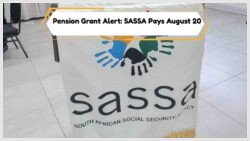August Shock: NSFAS Hack Unleashes R5,200 in Minutes via Viral WhatsApp Trick Among Students: In a surprising turn of events this August, students across South Africa were abuzz with news of a startling hack involving the National Student Financial Aid Scheme (NSFAS). This digital exploit reportedly enabled students to unlock a staggering R5,200 in mere minutes, spurred by a viral trick circulated on WhatsApp. The incident quickly became the talk of campuses nationwide, igniting discussions about cybersecurity and the vulnerabilities of digital financial platforms. With the ubiquity of WhatsApp among students, the trick spread like wildfire, prompting both excitement and concern. As authorities scramble to address this breach, the event serves as a stark reminder of the ever-evolving landscape of online security threats and the need for robust protective measures.
Understanding the NSFAS WhatsApp Hack
The recent breach involving NSFAS has left many questioning how a viral WhatsApp trick could lead to such a significant financial windfall for students. Essentially, this hack exploited vulnerabilities within the NSFAS system, allowing unauthorized access to student accounts. The process involved sharing a link via WhatsApp, which students were encouraged to click. Once clicked, this link initiated a series of automated transactions that credited the students’ accounts with R5,200. While the exact technical details remain under investigation, the ease with which the hack was executed has raised alarms. Cybersecurity experts emphasize that such breaches are often facilitated by a combination of technical loopholes and user complacency. As a result, there is a growing call for both improved security measures and increased awareness among users to safeguard against similar incidents in the future.
 Discover the Fastest Way to Unlock NSFAS Funds: Thousands Swear by This Proven Appeal Format!
Discover the Fastest Way to Unlock NSFAS Funds: Thousands Swear by This Proven Appeal Format!
- Exploited system vulnerabilities
- Viral spread via WhatsApp
- Automated transactions initiated
- Increased calls for cybersecurity
- User complacency a contributing factor
Impact on Students and Institutions
The repercussions of the NSFAS hack extend beyond financial implications, affecting both students and educational institutions. For students, the immediate impact was a mix of unexpected financial gain and the looming threat of potential repercussions for participating in the hack. Many students expressed concern about the possibility of having to repay the funds or facing disciplinary actions. Meanwhile, educational institutions found themselves grappling with the fallout, as the breach called into question the security of their financial aid systems. Universities and colleges across the country are now under pressure to review and enhance their cybersecurity protocols to prevent future incidents of this nature.
- Financial windfall
- Potential disciplinary actions
- Institutional pressure
- Review of cybersecurity protocols
- Broader implications for digital security
- Increased scrutiny of financial aid systems
- Communication challenges
- Reputation management
NSFAS’s Response to the Hack
In the wake of the hack, NSFAS has been swift in its response, aiming to reassure students and the public of its commitment to rectifying the situation. The organization has launched a comprehensive investigation to identify the source of the breach and has pledged to implement enhanced security measures. NSFAS also issued a statement advising students to refrain from engaging with suspicious links and to report any unusual account activity immediately. Additionally, NSFAS is collaborating with cybersecurity experts and law enforcement agencies to track down those responsible for orchestrating the hack. Despite these efforts, the incident has underscored the challenges faced by organizations in safeguarding sensitive financial data in an increasingly digital world.
 August 17, 2025: R1,250 Foster Child Grant Payout Begins – Ensure You Receive Your SMS Alert!
August 17, 2025: R1,250 Foster Child Grant Payout Begins – Ensure You Receive Your SMS Alert!
- Comprehensive investigation launched
- Enhanced security measures promised
- Public reassured of commitment
- Collaboration with cybersecurity experts
- Advice issued to students
Lessons Learned from the August NSFAS Hack
Reflecting on the August NSFAS hack, several key lessons have emerged for both students and institutions. Firstly, the incident highlights the importance of maintaining vigilance when interacting with digital platforms, particularly in the context of financial transactions. Students are encouraged to scrutinize any unsolicited messages or links and to prioritize the security of their personal information. For institutions, the hack serves as a wake-up call to regularly assess and upgrade their cybersecurity infrastructure. By fostering a culture of digital literacy and security awareness, both students and institutions can better protect themselves against future cyber threats.
| Lesson | Action | Outcome |
|---|---|---|
| Vigilance in digital interactions | Scrutinize messages | Enhanced security awareness |
| Regular security assessments | Upgrade infrastructure | Improved defense mechanisms |
| Promote digital literacy | Conduct workshops | Increased resilience |
| Collaboration with experts | Engage cybersecurity firms | Access to specialized knowledge |
| User education | Develop training programs | Informed user base |
| Timely incident response | Establish protocols | Minimized impact |
| Strengthen communication channels | Enhance transparency | Build trust |
| Monitor emerging threats | Stay updated | Proactive threat management |
Cybersecurity Measures for Students
The NSFAS hack serves as a crucial reminder for students to adopt proactive cybersecurity measures. Students are advised to regularly update their passwords and use multi-factor authentication whenever possible. Additionally, avoiding the use of shared or public devices for sensitive transactions can mitigate the risk of unauthorized access. By staying informed about the latest cybersecurity threats and adopting safe online practices, students can protect their financial and personal information.
- Regularly update passwords
- Avoid shared devices for transactions
- Use multi-factor authentication
- Stay informed about threats
- Adopt safe online practices
Future of Digital Financial Aid Platforms
As the digital landscape continues to evolve, the future of financial aid platforms like NSFAS will hinge on their ability to adapt to emerging cybersecurity challenges. Institutions are likely to invest in advanced technologies such as artificial intelligence and machine learning to enhance their security measures. Moreover, fostering partnerships with cybersecurity firms can provide valuable insights into potential vulnerabilities. By prioritizing innovation and security, financial aid platforms can ensure the safe distribution of funds to students in need.
- Advanced security technologies
- Partnerships with cybersecurity firms
- Fostering innovation in security
- Ensuring safe fund distribution
FAQ Section
What exactly happened in the NSFAS hack?
Students were able to exploit a vulnerability in the NSFAS system through a viral WhatsApp trick, resulting in unauthorized financial transactions.
How did students find out about this hack?
The trick spread rapidly via WhatsApp, with students sharing the method through group chats and social media platforms.
Is NSFAS taking any action against the students involved?
NSFAS is currently investigating the breach and has not yet announced any specific actions against students.
What measures can students take to protect themselves online?
Students should regularly update their passwords, use multi-factor authentication, and avoid shared devices for financial transactions.
How is NSFAS improving its security measures?
NSFAS is collaborating with cybersecurity experts to enhance its security infrastructure and prevent future breaches.
How did students exploit an NSFAS hack through a viral WhatsApp trick?
By gaining R5,200 in minutes through the NSFAS hack.




